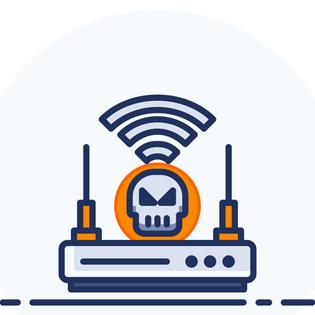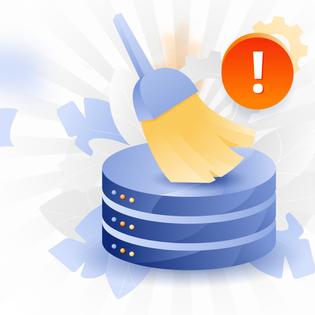-
Competitive introductory price
-
Unique features such as an on-screen keyboard
-
Unclear data sharing practices
Advertiser Disclosure
All About Cookies is an independent, advertising-supported website. Some of the offers that appear on this site are from third-party advertisers from which All About Cookies receives compensation. This compensation may impact how and where products appear on this site (including, for example, the order in which they appear).
All About Cookies does not include all financial or credit offers that might be available to consumers nor do we include all companies or all available products. Information is accurate as of the publishing date and has not been provided or endorsed by the advertiser.
Editorial Policy
The All About Cookies editorial team strives to provide accurate, in-depth information and reviews to help you, our reader, make online privacy decisions with confidence. Here's what you can expect from us:
- All About Cookies makes money when you click the links on our site to some of the products and offers that we mention. These partnerships do not influence our opinions or recommendations. Read more about how we make money.
- Partners are not able to review or request changes to our content except for compliance reasons.
- We aim to make sure everything on our site is up-to-date and accurate as of the publishing date, but we cannot guarantee we haven't missed something. It's your responsibility to double-check all information before making any decision. If you spot something that looks wrong, please let us know.
Navigating the endless products out there to find the best antivirus software can feel overwhelming. Whatever your tech level, there are a myriad of products available.
But not all products are recommended, and one of those is Kaspersky. This formerly popular antivirus has garnered attention since 2017 when the Federal Communications Commission (FCC) named it a threat to national security because of its ties to Russia. (Kaspersky disagrees.[1])
Kaspersky Standard, the Kaspersky antivirus plan reviewed here, is useful and straightforward, but is it worth the potential security risk? After reviewing the way the company uses and shares data and comparing it against the strength of protection, we aren’t sure it is. Keep reading to find out why we don't recommend Kaspersky and learn more about the antivirus programs we do recommend, such as McAfee, Norton 360, and AVG.
Who is Kaspersky best for?
Kaspersky antivirus features
Kaspersky test results
Our Kaspersky Standard antivirus experience
Kaspersky compatibility
Kaspersky customer support
Kaspersky cost
Kaspersky antivirus FAQs
Bottom line: Is Kaspersky good?
Kaspersky antivirus overview
| Price | $38.49–$74.99/first yr |
| Free plan | Yes |
| Number of devices protected | 3 to 5 |
| Malware scans | Manual and scheduled |
| Firewall | Windows only |
| Phishing protection | Partial — no Safari support |
| Parental controls | Kaspersky Premium only |
Unfortunately, we can’t recommend using Kaspersky because of the potential national security threat. The product also collects too much extremely personal data to be considered safe.
Who is Kaspersky best for?
- Kaspersky is ideal for PC users who want excellent protection proven by AV-TEST results but also understand the controversy over the country of origin of the product.
According to the company, Kaspersky works for individuals, families, and businesses, and the product itself is fairly easy and straightforward. With an introductory price range of $38.49–$74.99/first yr, the Kaspersky antivirus program is advertising itself as a trustworthy, affordable product.
It’s even gone as far as to rebrand each of its offerings from Kaspersky Internet Security and Kaspersky Total Security to Standard, Plus, and Premium. There’s also a free version that scans and cleans. Sometimes products rebrand, especially when expanding their offerings, so this move isn’t unusual.
Kaspersky has a clean, user-friendly interface and relatively straightforward controls. The PC version has many more features than the Mac version, and PC users will find more offerings with Kaspersky.
For both PC and Mac users, Kaspersky boasts some impressive features. The web plugin reports on blocked trackers. It also provides a separate keyboard to avoid keylogging and has a section specifically for financial transactions. The device protection on your actual machine has a clean, easy-to-use interface.
If the security woes aren’t a concern, Kaspersky is an easy and affordable solution for someone looking for enhanced web monitoring as long as they’re using a PC. Mac users will find they get much less bang for their buck.
Kaspersky antivirus pros and cons
- Easy to use
- Lots of reporting data
- Competitive introductory price
- Unique features such as an on-screen keyboard
- Unclear data-sharing practices
- Fewer features on Apple devices (macOS and iOS)
- Difficult to troubleshoot alone
Kaspersky antivirus features
The best features of the Kaspersky Standard antivirus product are the web monitoring and scanning features:
- Web antivirus
- Web tracking
- Safe Money
- URL advisor
- On-screen keyboard
- Full scan
- Quick scan
- Scheduled scan
The scan features are easy to use and provide the information from the scans in a clean and understandable format. The initial full scan did take nearly 30 minutes, but the same full scan we ran the next day only took 18 minutes. Neither scan interfered with the functionality of our MacBook. It was easy to continue using our device while the scan ran in the background.
The web monitoring tools are effective and informative. When tested on the YellowOctopus meme website, the tools picked up and blocked many of the tracking cookies other sites had placed on the site.
Tracking cookies from Facebook were expected, but seeing the tracking cookies from YouTube, Snapchat, and Google was interesting. The Google tracking cookies that Kaspersky blocked were actually from Kaspersky’s site.
Kaspersky web monitoring set off our alarms
To receive all of the web monitoring services, you have to enable the browser extension which comes with an alarming notice.

This notification didn’t come from Kaspersky. It was the built-in security on the Mac that generated the alert.
Depending on your level of concern with monitoring, this could be a deal breaker. As a tester, this was part of the product I didn’t want to turn on. The statements from Kaspersky on how they handle data made me especially wary.

If you live in a 14 Eyes country like the U.S., this means everything you do online may be readily available to the government.
Another item to note is that Kaspersky only gives the U.S. a mention in this disclaimer but doesn’t necessarily state the U.S. is exclusively the only country privy to your information. “The laws of several jurisdictions” is vague and can mean your data could be shared anywhere worldwide where Kaspersky operates.
Since Kaspersky was created by a Russian national and has headquarters in Moscow, it’s easy to see why the FCC banned Kaspersky from all government systems given the amount of information collected.
Malware and antivirus scan
Kaspersky offers both manual and automatic scanning features. You can do a full or quick scan at any time. There is also the option to schedule a scan. Running a full scan while still using your device doesn’t seem to be a problem.
The initial full scan took about 30 minutes. The product app on the desktop showed percentage progression and gave an estimated remaining scan time. The estimated scan time wasn’t accurate, as most aren’t, and changed as the percentage of scan progressed.
The quick scan took less than 20 seconds.
Neither scan was difficult to perform. The control panel has easy-to-use buttons and displays all the information necessary.

Phishing protection
Kaspersky boasts anti-phishing and anti-spam features. It seems, however, that these features are exclusively for the Windows product. If you’re using a Mac, Kaspersky has plenty of features for privacy, but setting up phishing and spam protection doesn’t seem to be part of those options.
The website tracking option does have a settings menu that allows you to block tracking cookies and ads. There are no specific features for phishing or spam. After some extensive research online, it seems like these features aren’t available on Mac.

In addition to the lack of information on phishing and spam monitoring, we received this message when searching for how to activate the features on Mac.
We’re not sure which version to which they’re referring as both our Mac and Kaspersky are up-to-date. There is a possibility they mean the most recent version of Mac OS, Ventura. The Kaspersky website mentions it covers Mac 10.15 to 12, and Ventura is Mac 13.
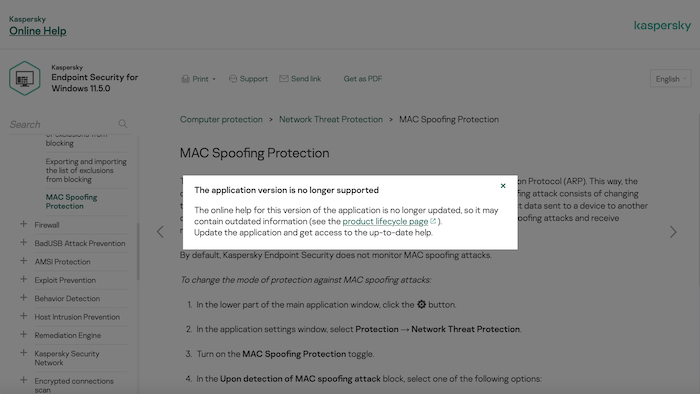
Firewall
On the main page of comparisons of what is offered in the different versions of Kaspersky, a firewall is listed in each of the offerings. This is only true for Windows computers.
When trying to find where the firewall option might be for Mac, we ended up having to do an internet search rather than finding the information on Kaspersky’s website.
There was no option in the on-site chatbox to ask about a firewall, so we called the number provided. At 6 p.m. PST on a weekday evening, it took less than 2 minutes to reach a live representative who, after some research, informed us there is no firewall for Mac built into the Kaspersky product.
Disclaimer: Macs have their own internal firewalls, so most companies don’t include them in their Mac versions. It took a lot of digging to find this information.
Real-time protection
The real-time protection Kaspersky offers is one of the best aspects of the product.

As you navigate the internet, there are real-time scanners looking at the web traffic crossing your machine. This is the best way for Kaspersky to pick up any malware or malicious code that may be trying to steal your information.
In an effort to really put this to the test, we went searching for the spammiest gimmicks we could. One we’ve seen over and over again is a $700 gift card for the fast fashion site SHEIN.
As you can see above, the website tracking feature shows you what has and hasn’t been blocked by Kaspersky. To date, the blocked versus not blocked is about a 60/40 split — 40% of “tracking attempts not blocked” is a lot.

When we found a blog that had a link to the SHEIN gift card giveaway, we looked at the website tracking report. There was a host of tracking cookies that were blocked by Kaspersky.

After being prompted by the site to enter an email address, we decided to create a new Gmail account. Kaspersky real-time protection provided us with an on-screen keyboard to protect from keylogging. Keylogging, in case you’re unfamiliar, is when a hacker is able to see the individual keys you strike on your keyboard. This is usually achieved through a Wi-Fi hack during a Man-in-the-Middle attack.
We thought this feature was great until we tried to log back into the newly created Gmail account and found there were no passwords saved in our password manager. This could lead to a serious problem, especially if you don’t know your passwords won’t be saved. (We’re currently locked out of this newly created account, by the way.)

The real-time protection provided by the extension did block a lot of tracking cookies from logging our information on both the spammy site and when we logged into the Gmail account. It also allowed through almost as many as it blocked, still at a 60/40 percentage split, so we don’t consider this a successful feature.
Ransomware protection
The main goal of every antivirus product is malware protection. Ransomware is a form of malware that takes your files hostage and only releases them when you agree to pay the ransom.
Kaspersky’s ransomware protection features are rolled into the security features.
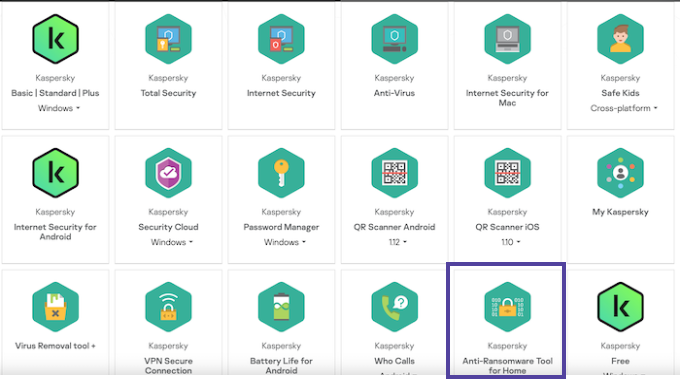
Since we tested Kaspersky on a Mac, we had to go to the support library to find the tool.

As with many of the touted features in the Kaspersky product, we discovered the ransomware protection tool was only supported on Windows-based systems.
Online banking protection
Part of the browser extension for Kaspersky is dedicated to financial security. The Safe Money feature from Kaspersky is meant to guard your data while visiting websites that collect and use financial information, like your mobile bank site or an online retailer.

Unfortunately, it was again discovered that the Safe Money feature is not available for Mac or Safari browsers. In fact, even if you’re on a Windows operating system and you use a safe browser like Brave, you still won’t have access to the Smart Money feature.
Bonus features
Kaspersky does provide a few interesting extra features like the URL advisor and on-screen keyboard.
URL advisor
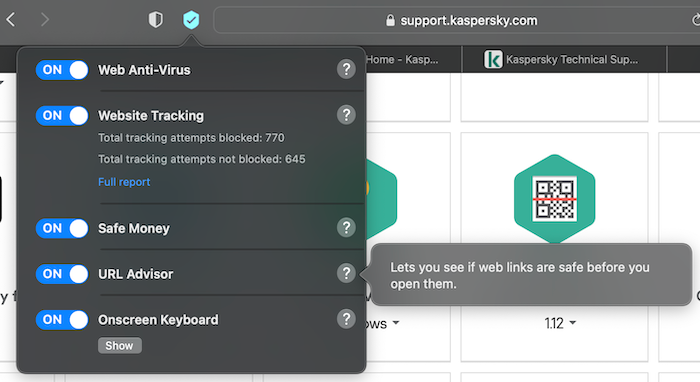
The URL advisor is supposed to see if a link is safe before you click it. This feature seems particularly helpful, especially since phishing emails and links are some of the most prevalent methods for hackers today.
On the Kaspersky browser extension, the toggle shows on. However, we never saw where to use this feature, and it didn’t appear on screen like the on-screen keyboard did when setting up a testing Gmail account.
When we tried to search how to turn this feature on in Safari, we were sent to Kaspersky’s forum page with endless articles that had one keyword like “URL,” “Advisor,” or our last search, “Safari,” without giving us a direct answer.
In the end, trying to find a way to use the URL advisor on Safari was too tedious, and we gave up.
On-screen keyboard

The on-screen keyboard was one of the only features we found that worked quickly and without prompting. Several times while exploring the internet with the Kaspersky extension turned on, the on-screen keyboard popped up.
This is actually a great feature. Keyloggers are hackers that use man-in-the-middle attacks to steal login credentials. Having an on-screen keyboard can circumvent this attempt and add an extra layer of security to browsing sessions.
The downside to the on-screen keyboard is that you have to use your mouse to click the keys, which is the entire point. Obviously, if you use your keyboard, the security feature would be moot. That’s an acceptable inconvenience.
What we found to be an unacceptable inconvenience was the inability to save a new password in our password manager while using the on-screen keyboard.
Upon further research, we found that Kaspersky offers a password manager with its higher-cost product offerings. But we’re not sure if the on-screen keyboard would work with Kaspersky’s proprietary password manager.
Webcam protection
One of the best features. It allows you to turn off access to your webcam. Even if you do manage to pick up a form of spyware that hacks your camera, this program blocks access.
Ad blocker
The ad blocker feature stops annoying pop-ups as well as ads that may contain malware or spyware for enhanced privacy protection.
Some of the other notable features available on Kaspersky products:
- Kaspersky VPN: The virtual private network (VPN) wasn’t included with Kaspersky Standard but was available for purchase in our account dashboard. It’s included with Plus and Premium subscriptions.
- Password manager: The Kaspersky password manager feature wasn’t included in the Standard package. It does come included on the Plus and Premium subscriptions.
- Device optimization tools: Device optimization tools seem to only be offered on the Windows product, but they do come included with all paid versions of Kaspersky.
- Safe Money: Not available on Safari. Available on all paid versions of Kaspersky when using Windows, Chrome, Yandex, or Firefox.
- Kaspersky Safe Kids: This wasn’t included in the Standard offer but was available to purchase separately or comes with the Premium product.
Kaspersky test results
AV-TEST is an independent researcher that tests cybersecurity products based on industry standards. The rating system is between 0 and 6 with 6 being the highest score.
AV-TEST puts all products through rigorous testing and is the most trusted source for independent testing for security products. Kaspersky regularly scores perfect or near perfect with each of its offerings when it comes to protection.
| Test type | Windows 10 score[2] | macOS Ventura 13.2.1 score[3] | Android 11 score[4] |
| Protection | 6 | 6 | 6 |
| Performance | 6 | 6 | 6 |
| Usability | 6 | 6 | 6 |
Android and macOS test results from March 2023.
Our Kaspersky Standard antivirus experience
As we’ve mentioned throughout this review, we tested the Kaspersky Standard software on a MacBook Pro running the Ventura 13.0.1 operating system with an M2 chip. It should be noted that, at the time of writing, Kaspersky didn’t say on its site that it covered macOS 13 and only covered macOS 10.15 to 12.
The only features that really worked for us were the scan, website tracking, and on-screen keyboard. We found the scan feature to be the most user-friendly. It was also the only portion of the product that worked completely and without an inconvenience to our experience. The dashboard in the app is also clean and is easy to manage.

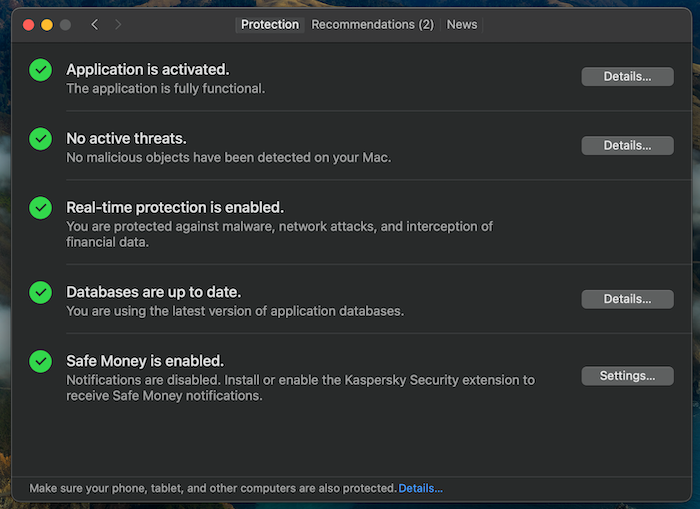
While running the scan, we didn’t notice any slowdown of normal usage on our Mac. We found both the full scan and quick scan to be extremely easy to use. We didn’t use the selective scan, but it is an option. Here is a breakdown of the scans we used:
- Initial full scan: 30 minutes to complete, 639,000 files scanned
- Next-day full scan: 18 minutes to complete, 527,000 files scanned
- Quick scans: Less than 20 seconds to complete, 2400+ files scanned

We had no threats detected on our system. Kaspersky claims threats are quarantined and automatically deleted after 30 days. You can toggle manual threat management off or on if you’d rather isolate and delete the files yourself.
Every other part of our Kaspersky for macOS experience was frustrating and took much longer than it should have. Searching the site for answers, finding the right chatbox prompt, and navigating the support forum were all time-consuming.
We had to enable the browser extension to get the web monitoring tools. It wasn’t difficult and the built-in installer walked us through activating them.

The other features not included with the Standard product are included with the more expensive offerings. Some were also available for purchase through our dashboard.
Kaspersky compatibility
There’s a significant difference in functionality between operating systems and devices for the Kaspersky product. But Kaspersky claims compatibility with the following:
- Microsoft Windows 11, 10, 8, 8.1, and 7
- macOS versions 10.15 to 12
- Android tablets and smartphones running versions 8 to 13
- iOS devices (iPad and iPhone) running versions 15 to 16
Kaspersky customer support
Kaspersky provides multiple types of support for its product. The most available is the online help library which is organized by feature. The library includes FAQs and common fixes.

There’s also a chatbot on the page. The chatbot comes with preloaded topics for the most common issues. The chat also begins by letting you know you can easily reach Kaspersky support by phone and provides the phone number.
The phone support rep was empathetic, knowledgeable, and willing to help when she didn’t know the answer. I called regarding the firewall for Mac and the entire exchange took about 15 minutes. The representative did put me on hold, but that was so she could thoroughly answer my question and make sure I had all the information on the firewall feature.
If you want 24/7 device support you’ll need to purchase the premium version.
Kaspersky cost
Kaspersky offers three products for home users: Standard, Plus, and Premium. The first year is advertised as 40% to 45% off with the Standard price starting at $38.49/first yr, Plus starting at $52.99/first yr, and Premium starting at $74.99/first yr. After the first year, those prices jump to $69.99, $99.99, and $149.99, respectively. It’s also worth noting that the Premium starting price varied depending on where on the site we looked.
Kaspersky’s pricing is on par with other products offering similar features, such as Norton 360, McAfee, and Bitdefender. But based on the security risks with Kaspersky’s country of origin and data collection, we’re not sure it’s worth it.
Kaspersky plans and prices
| Kaspersky Standard | Kaspersky Plus | Kaspersky Premium | |
| Price for first year | $38.49/first yr | $52.99/first yr | $74.99/first yr |
| # devices supported | 3–10 | 3–10 | 3–20 |
| Compatible with | Windows, macOS, Android, iOS | Windows, macOS, Android, iOS | Windows, macOS, Android, iOS |
| Manual and auto scan | |||
| Real-time protection | |||
| Online banking protection | |||
| Phishing protection | |||
| Firewall | |||
| Ransomware protection | |||
| Performance optimization tools | |||
| VPN | |||
| Password manager | |||
| Identity theft protection | |||
| Parental controls | |||
| Details | Learn More | Learn More | Learn More |
Kaspersky antivirus FAQs
Should I delete Kaspersky?
Maybe. If you don’t like the amount of data collection, especially regarding your browsing activity, then yes.
Is Kaspersky better than McAfee?
No. McAfee and Kaspersky have many of the same features, but McAfee hasn’t been named a national security threat by the FCC.
Is Norton better than Kaspersky?
Yes. Norton has been around longer and has better detection rates and value for money.
Is Avast or Kaspersky better?
Kaspersky offers better value for money, but Avast doesn’t come with potential security threats.
Will Kaspersky remove existing viruses?
Yes, Kaspersky's scan and clean feature will remove an existing computer virus.
Bottom line: Is Kaspersky good?
Is Kaspersky good at what it does? If you’re running Windows systems then yes. It’s consistently rated high. But running it on a macOS is a complicated process that left this seasoned cybersecurity expert frustrated and annoyed.
Unfortunately, we can’t recommend using Kaspersky because of the potential national security threat. The product also collects too much extremely personal data to be considered safe.
5 Kaspersky antivirus alternatives
There are other products out there that cost similar amounts and offer similar features without the potential for handing over your data to foreign governments. If you're not sold on Kaspersky, here are some alternative antivirus programs to check out:
1. AVG
-
Free version comes with malware, spyware, and ransomware protection
-
Includes unsafe email attachment blocking
-
Various scanning options may be confusing to some people
A tried and true antivirus, AVG also had perfect scores from AV-TEST. Additionally, it has a decent free plan so you can try it out, and the paid version of AVG is well worth it thanks to platinum-level security features like real-time phishing protection and Wi-Fi security.
2. TotalAV
-
High level of antivirus protection
-
Protection from malicious viruses, malware and dangerous websites
-
User-friendly interface and overall app
-
Lacks firewall protection
TotalAV is another top contender when it comes to third-party protection testing. It earned perfect scores from AV-TEST, and also offers bonus features to keep your devices operating quickly and smoothly. On top of all that, we loved how easy it was to set up TotalAV. The interface was incredibly user-friendly and worked efficiently on our MacBook.
3. McAfee
-
All-in-one protection for your personal info and privacy
-
Excellent antivirus protection
-
Additional features like a file shredder and parental controls
-
Multiple pop-ups for text notifications can be annoying
If you need a more budget-friendly antivirus that still boasts lots of bells and whistles, McAfee is worth a look. Even its lowest-priced plan, Plus, still comes with parental controls, a VPN, and ransomware protection. Plus, you can also opt to purchase McAfee antivirus protection for an unlimited number of devices. That makes it a great choice for large families or even small businesses.
4. Bitdefender
-
Antivirus software offering reliable security
-
Simple yet powerful interface tools
-
Perfect protection score in third-party tests
-
Premium features incur additional subscription fees
A well-respected newcomer to the antivirus arena, Bitdefender offers multiple price points so you can pick and choose the level of protection you need. We also loved to see perfect scores for Bitdefender from AV-TEST, as well as it's low impact to our device speed while we ran scans.
5. Surfshark Antivirus
-
Comprehensive malware protection
-
Unlimited device coverage
-
No standalone antivirus plan
You might recall Surfshark, one of our top-recommended VPNs. We're happy to say Surfshark Antivirus also ranked high on the charts during our tests with its user-friendly dashboard and support for unlimited devices. It comes as part of Surfshark One, a comprehensive suite of security products that includes a VPN, a private search engine, and data breach alerts.
Read Our Surfshark Antivirus Review
-
Competitive introductory price
-
Unique features such as an on-screen keyboard
-
Unclear data sharing practices
[1] Kaspersky Statement on the FCC Public Notice
[2] Test Kaspersky Internet Security 21.3 for Windows 10


